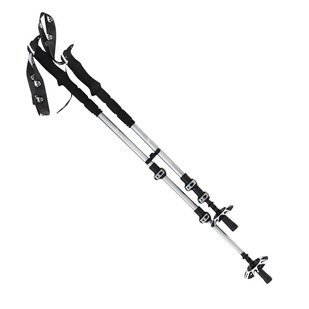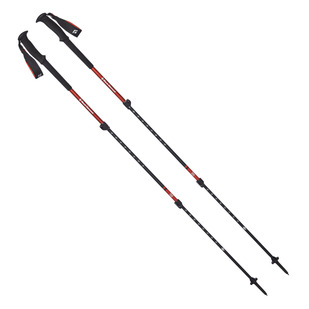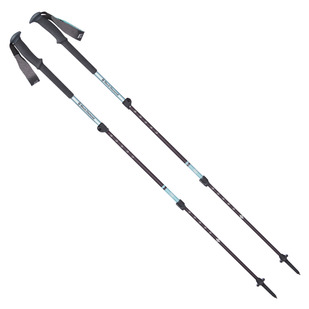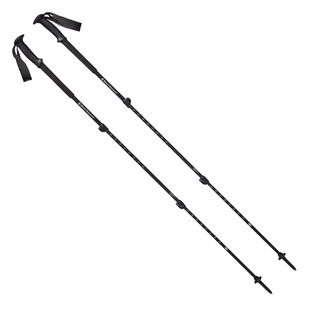How to Choose the Best Hiking Poles?
To reach your full hiking potential this fall, discover the benefits of hiking poles and, most importantly, which ones will best suit your activities and lifestyle!
WHY USE HIKING POLES?
There are many reasons to use hiking or trekking poles. They are mainly used to make your hike easier, whether it’s an all-day hike, an overnight hike, or just a few hours of walking.
Impact Reduction
By distributing the weight between your arms and legs in a balanced way, hiking poles help reduce the impact on your joints: knees, ankles, hips, and even the spine! When hiking up a mountain, poles are also useful as they help take some of the weight off your legs.
In other words, hiking poles play a cushioning role. This is especially useful when carrying a backpack or heavy loads that tend to destabilize.
Better Balance
The load distribution offered by the poles contributes to a better balance. This increased stability supports you through all kinds of obstacles: uneven slopes, under-groomed trails, etc. The risk of injury is reduced, both during the hike and in the long run!
Better Hike, Better Health
In addition to absorbing some of the physical effort, hiking poles encourage better posture throughout the hike and stimulate better circulation in the hands, which often swell during physical activity.
By making it easier for you to work your way up and down the mountain, this hiking accessory allows you to maintain a steady walking pace, reduce muscle fatigue, and regulate your breathing. Yes, hiking poles even have cardiovascular benefits!
There is nothing like a tool that allows you to reach the summits more easily while improving your physical condition.
HOW TO CHOOSE THE BEST HIKING POLES?
Fall, the most beautiful season for hiking, is here! And what’s great about hiking is that it’s accessible for people of all skill levels. However, whether you are younger or older, a beginner or an expert, it’s important to be well equipped before heading out.
Have you ever had a knee or back pain while hiking? Have you ever considered buying hiking poles? Which ones should you choose? Are you familiar with their use?
Whether you enjoy long hikes or prefer shorter trails, we’ve made it easy for you to find your perfect hiking accessories. Here are a few things to think about when it comes to choosing the right hiking poles for you.
The Height
Fortunately, most models on the market are adjustable and/or retractable. However, we recommend that you choose a pole length that is appropriate for your height in order to get the most out of it.
The ideal size of hiking poles can be determined by holding them upright against the ground. Just like alpine skiing, your arms should be at right angles. In other words, the distance between your wrists and the ground in this position gives you the right length for your hiking poles.
Telescopic or Foldable?
In the same vein, it may be relevant to choose between telescopic or foldable hiking poles. The telescopic is often more robust while the foldable is lighter and usually has a locking mechanism.
The Rod
When it comes to the rod, you can choose between carbon and aluminum. Carbon is lighter, but less resistant—meaning fragile—which is ideal when you are already carrying a heavy load or need to move with agility. Aluminum, on the other hand, is a more economical, rigid, and durable option … although it weighs a bit more.
For occasional hikers, we recommend the GV 5067 Adult Trekking Poles, which promise tremendous stability and can be adjusted with ease. Made of aluminum, they manage, with their aerodynamic shape, to combine lightness and rigidity. In addition, they have an ergonomic grip, an adjustable strap, and non-slip tips, as well as summer and winter baskets.
The Grips
When it comes to the choice of grips, you should opt for a material that is adapted to your needs. Grips are very important; they allow you to stabilize yourself on rough trails and must be comfortable since you typically use them for many hours at a time.
Your first option is to go with plastic grips, which are generally associated with entry-level poles and offer a good quality/price ratio. Rubber grips are more durable and also propose a great quality/price ratio. While they might give you blisters if used during longer hikes, they are better suited for winter adventures, when your hands are protected by gloves.
Note that plastic and rubber can make your hands sweat and absorb ambient temperature. Choose them for shorter trails or if you’re more of an occasional adventurer.
Opt for comfort with foam grips, which are not only able to wick away sweat, but are also generally more ergonomic. However, if you prioritize strength and durability, this material is not the best option.
For maximum grip, look no further. Cork grips do not absorb water or sweat and adapt to the shape of your hands. Not only are they comfortable, but they also last a reasonable amount of time.
We tend to recommend materials such as foam and cork for more experienced hikers who often take on more strenuous trails.
Black-Diamond Trail trekking poles are a true benchmark in terms of preferred models, including optimal handling, thanks to the soft rubber grip and lever-operated FlickLocks adjustments. With interchangeable straps and tips, these poles are also compatible with ski baskets.
The Trail W women’s trekking poles offer the same benefits as the previous model, but will usually fit adventurous women better.
The Straps
The wrist straps promise excellent stability and prevent you from losing your poles while hiking. They slip on around the wrists and reduce friction and hand fatigue.
Make sure they are easily adjustable, especially in the winter when you have to do it with gloves or mittens. It’s even better if they are comfortable and the material breathes!
The Baskets
Depending on the trail, the baskets prevent the poles from getting stuck between two rocks or from sinking into snowy or muddy terrain. Therefore, they should be replaced with a larger size when cold weather arrives.
The Black-Diamond Trail Back adult hiking poles are ideal for enjoying the fall at a small price. The strap is made of nylon webbing and comes with an ergonomic non-slip rubber grip for unparalleled comfort on steeper slopes. The dual FlickLock® mechanism makes sure you can adjust your poles to your liking and the Trekking baskets allow you to move through softer terrain.
The Tips
The tips, either carbide-tungsten or steel, help maximize traction: like car tires, they grip the surface. Carbide tips tend to offer superior quality. We recommend them for more adventurous hikers who hit the trails on a regular basis.
For a less expensive option, we recommend opting for steel tips, which are entirely suitable for casual hikers. Just remember that they wear out at a faster rate.
The End Caps
When there is a lot of asphalt and/or rocks, it is always best to cover the tips of your poles with rubber end caps. The end caps prevent you from slipping and naturally protect the tips.
While many of them are suitable year-round, it may be appropriate to get end caps that are specifically adapted to the trail, for example, for a mountain descent or for a snowy route.
A FEW TIPS
To allow you to climb the trails without exhausting yourself, we suggest that you shorten your hiking poles by a few centimetres (5 to 10 centimetres for steep slopes). When climbing, the poles encourage greater stability and serve as a fulcrum to better propel you to the top!
On the other hand, don’t forget to lengthen your poles during the descent to lighten the weight on your joints and allow you to slow down. In order to avoid injuries, the straps can be removed in case of a fall.
OUR RECOMMENDATIONS
We hope this guide was helpful and offered a comprehensive hiking pole overview. The main thing to think about is how often and how hard you want to hike. Then, head to an Atmosphere store to pick out a model that suits your needs!
Now, get out in the fresh air—the fall scenery is waiting!










